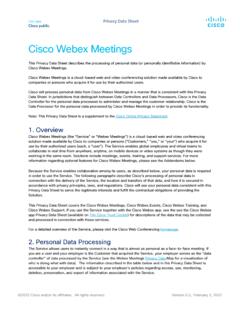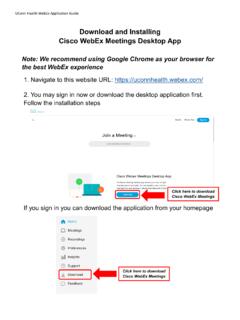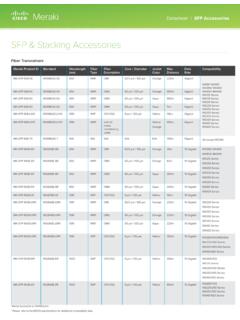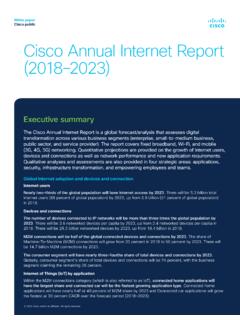Transcription of How to Connect to VPN: Cisco AnyConnect Secure Mobility …
1 How to Connect to VPN: Cisco AnyConnect Secure Mobility Client June 13, 2016 For help with any of the instructions below, please contact the AIMS Help Desk at 265-6900 or email TABLE OF CONTENTS Create a Desktop Shortcut .. 3 Connect to Wireless Internet .. 5 Connect to the VPN .. 8 Map Network Drives .. 10 Using the Start Before Login Feature .. 11 Create a Desktop Shortcut Before logging into Cisco AnyConnect , verify that you have a shortcut on your Desktop. If you do not, follow the steps outlined below: 1. Locate to create a Desktop shortcut with one of the following methods: a. Method one: Click Start then click All Programs.
2 Click the Cisco folder; click the Cisco AnyConnect Secure Mobility Client folder, then rightclick the Cisco AnyConnect Secure Mobility Client icon. This will bring up a list of options. Hover over Send to, then click Desktop (create shortcut). Figure 1 b. Method two: With Windows 7, click the Start button. In the Search field, type Cisco AnyConnect . Right-click the Cisco AnyConnect Secure Mobility Client icon. This will bring up a list of options. Hover over Send to, then click Desktop (create shortcut). *Now that you have a desktop shortcut, you can double-click the icon whenever you want to launch Cisco AnyConnect in the future. Now that you have a shortcut for Cisco AnyConnect , let s outline the three steps for logging into the VPN: 1 Connecting to Wireless Internet Figure 2 2 Connecting to the VPN 3 Map Network Drives Each step will be discussed in more detail below.
3 Connect to Wireless Internet When you are undocked and ready to Connect to the VPN, turn on the wireless switch located on the side or front of the laptop. Note that if you can see orange, the switch is turned OFF. 1. Place your cursor in the lower right hand corner of your screen and double click on the icon to open the available wireless connections. See Figure 3. Note: If you are not finding any wireless networks make sure you are in range of a wireless network and the switch on the side or front of the laptop is turned on. Figure 3 2. Click to select the wireless network you wish to use, check Connect automatically, and then click Connect as shown in Figure 4. Note: If you are in Business Services, your laptop should automatically Connect to wireless-bussvc when it is an available option.
4 Figure 4 3. Once you are connected, the wireless connection icon will appear like Figure 5. Figure 5 4. You are now connected to a wireless network. If you are connected to UW Net, you may need to authenticate that connection to the campus network. To do so, open Internet Explorer and try to navigate away from your homepage ( type in a new webpage address). You should be redirected to the page in Figure 6. Click Log in with NetID. 5. On the next page, enter your NetID and password, and then click LOG IN as shown in Figure 7. If you encounter problems with your NetID and/or password please call the DoIT Helpdesk at 264-Help. Figure 6 Connect to the VPN 1.
5 Launch Cisco AnyConnect . 2. The AnyConnect window will appear. Ensure that UW Dept VPN (central campus) is entered in the drop-down field. Click Connect . See Figure 8. Figure 7 3. In the login window that appears, ensure that AIMS_REMOTECLIENT is selected for the Group: field. In the Username: field, enter your username. In the Password: field, enter your password. Click OK. See Figure 9. *Note: Your username and password will be the same you use to get onto your computer. Figure 9 4. At the Welcome screen, click Accept as shown in Figure 10. Figure 8 Map Network Drives Locate the Map Network Drives icon on your Desktop and double-click it. This will launch a log-in script that will map your network drives.
6 It will close on its own. *If you do not have this icon on your Desktop, please contact the AIMS Help Desk. Figure 10 Using the Start Before Login Feature 1. Start up the Windows 7 computer, and you will arrive at the Ctrl + Alt + Del screen as shown in Figure 11. Simultaneously press the Ctrl, Alt, and Delete buttons on your keyboard. 2. At the login screen, press Esc on your keyboard or click the Switch User button. See Figure 12. Figure 11 Figure 12 3. Click on the blue button with the Network Logon rollover label located in the bottom, right-hand corner. See Figure 13. 4. In the AnyConnect window that appears, verify that UW Dept VPN (central campus) is selected, and then click Connect as shown in Figure 14.
7 Figure 12 Figure 14 Figure 13 5. Verify that the Group: selected is AIMS_REMOTECLIENT as shown in Figure 15. 6. In the Username: field, enter your AIMS domain login ID. In the Password: field, enter your AIMS password. Click OK. See Figure 16. 7. In the dialog box that appears, click Accept as shown in Figure 17. Figure 17 Figure 15 Figure 16 Figure 15 8. At the Choose User screen, click Other User as shown in Figure 18. 9. At the login screen, log in with your AIMS login ID and password. See Figure 19. Figure 18 Figure 19 10. After entering your login credentials successfully, the AIMS Login Script will run and you will receive a welcome message. Click OK as shown in Figure 20.
8 Figure 20 **Note: Every time you log off of the machine, this process will be required to log back in. If you do not complete this process, you will not have access to your network drives.




